Writings on the bottle
CONTENT
Identification:
– Indication Cognac
– Brand name
– Logo or emblem
– Additional name
– Producers address
– Name of distributor or importer
– Vendor and vendors address
– Barcodes
Description of contents:
– Cru
– Appellation Controlée
– Fine
– Early Landed
– Französisches Erzeugnis
– Ausländisches Erzeugnis
– Ageing designations
– Content
– Estimated sign
– Standard drink and UK unit of alcohol
– Alcohol content
Recognitions:
– Medals
– Royal or imperial warrants
Excise:
– Cotisation Sécurité Social symbol
– Excise-duty symbols
– Paper seal
– Ecotax symbols
– echantillon gratuit
Warnings and information symbols:
– Federal Law forbids reuse
– Government Warning
– Pregnancy icon
– Recycling symbol
– Tidyman symbol
– Tidyman glass symbol
– Green point symbol
– Dont drink and drive
Appendix: milliliters, fluid ounces and more
Indication Cognac
It is required to state on the label that the content is in fact cognac. If you can not find the word ‘cognac’, you can be pretty sure the bottle does not contain real cognac. An exception can be made for some very old bottles, way before the Second World War. These bottles can only have the brand name stated, or are just called brandy. But most bottles that say brandy – and certainly all younger bottles – are not real cognacs.
If you can not find the word ‘cognac’, you can be pretty sure the bottle does not contain real cognac. An exception can be made for some very old bottles, way before the Second World War. These bottles can only have the brand name stated, or are just called brandy. But most bottles that say brandy – and certainly all younger bottles – are not real cognacs.
Brand name
The brand name is always on the label. It is not necessarily the same as the producer’s name. The name of the producer is sometimes not mentioned at all, for instance for some supermarket chains that like to sell cognac under their own name.
Logo or emblem
Almost each brand has its own logo or emblem. It can be in the way the name is written, or it can be a picture of something characteristic to the brand or the owner. It serves as an eye-catcher, so the buyer can easily recognize the bottles of his favorite brand. It can be a picture of the house, a picture of a person, a coat of arms or an allegorical image.
Additional name
Sometimes a bottle is worthy to get its own name. They are sometimes called after names of relatives or they have beautiful poetic names.
Producers address
The name of the producer is usually mentioned, as is his address. This is not however obligated. Very often it is printed at the bottom of the label. Sometimes on the back-side of the bottle. Very often just a postcode and place name.
Name distributor or importer
Bottles are sometimes imported by companies in such great numbers, that they have asked to have their name and address stated. They are not necessarily the vendor. It can be stated as the firm that imported the bottle or even the firm that has bottled the cognac.
If there is a B-code on the bottle followed by three numbers, that is the importer code for South African importers. (for instance: B421)
Vendor and vendors address
More or less the same as mentioned above for persons within the distributional network.
Barcodes
From around 1980, barcodes were rapidly introduced. For the purpose of quick recognition of name, price and category in the purchasing process and inventory management.
Cru
The cru indicates from which region the cognac originates. There are six different cru’s and each cru corresponds with a certain quality. They are, in order of quality: grande champagne, petite champagne, borderies, fins bois, bons bois and bois ordinaires. If ‘cru’ is stated on the bottle it means that all of the cognac originates from that cru. A ‘blend’ is the opposite of a ‘cru’. A blend cognac consists of cognacs of different cru’s.
Noteworthy is the term ‘fine champagne’. It is not really a cru, but it means the cognac is made out of grande champagne and petite champagne only, and at least 50% grande champagne. It is not to be confused with ‘fine cognac’, which has no other meaning than to say it is ‘good cognac’, for wathever that is worth.
Appellation controlée
Appellation Controlée is a certification to guarantee the cognac was produced in the specified region. So you can have ‘Appellation Cognac Controlée’, but als in combination with the cru: ‘Appellation Fins Bois Controlée’. There is one acception: the last cru (bois ordinaires) is the only cru that not has the right to bear an appellation controlée specification. ‘Fine champagne’ on the other hand, does have this right.
Fine
The adjective ‘Fine’ can be used in combination with the word cognac, in combination with a cru-name or together with the word ‘champagne’. The first possibility does not have any real meaning other than to say it is ‘good’ cognac. In combination with a cru-name it is saying that the cognac for 100% originates from the specified region (cru). Together with the word ‘champagne’ it guarantees that a minimum of 50% originates from grande champagne and all the rest from petite champagne.
Early landed
It has long been a custom to ship cognacs to England very soon after distillation. Here they were stored for decades in damp cellars near the shores. These cognacs are called ‘early landed’. Since some years now, this is forbidden by the French law. To have the right to call it cognac, they are required to age in the region where they originate from.
Ageing designations
They are not required. They give information about the number of years a cognac has been stored in wooden casks before it was bottled. Some ageing designations are controlled by the BNIC, so the buyer has a warrant that the cognac is at least as old as it says it is. These are VS, VSOP, Napoléon and XO.
If there is no age indication whatsoever present, you can safely assume that the cognac is as young as a VS.
Other designations are not controlled by the BNIC. There exist well over a hundred of them. Some that are often used are: ‘de luxe’, ‘spécial’, ‘supérieur’, ‘vieille’, ‘vieille réserve’, ‘réserve de la famille’, ‘héritage’, ‘hors d’age’. They all correspond with a minimum number of years of the official designations, but are usually substantially older. But you have to believe the producer on this, because there is no official check.
Click here for a complete list of all age indications.
Content
It is obligatory to state the content of the bottle. This may be done in milliliters, centiliters or liters. On older bottles it could be mentioned using fluid ounces, quarts or pints, either in Imperial (UK) or in US measures. More on fluid ounces, quarts, pints and gallons in a separate paragraph below.
Estimated sign
The estimated sign is the letter ‘e’ standardized to look exactly like this: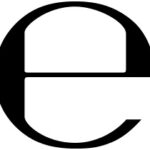
It certifies that the contents of the bottle comply with certain criteria that are specified, especially that the content is not less than the nominal quatity that is stated.
It was introduced in 1976 by a EU-directive.
Standard Drinks and UK unit of alcohol
Unit of masurement to measure the amount of alcohol someone has drunk, developed in the nineteen-eighties. In some countries it is mandatory to put the number of standard units it contains on the bottle. This way it should be easier to know how much alcohol someone has consumed. There are two major problems: each country uses a different standard and the glasses used for a drink usually deviate from the standard glass size for the drink.
developed in the nineteen-eighties. In some countries it is mandatory to put the number of standard units it contains on the bottle. This way it should be easier to know how much alcohol someone has consumed. There are two major problems: each country uses a different standard and the glasses used for a drink usually deviate from the standard glass size for the drink.
In the UK the standard drink was used between 1984 and 1987 in the UK guidelines for ‘safe limits’ for drinking. But they were replaced in the 1987 guidelines by units of alcohol, where 1 unit of alcohol equals 10 millilitres (or 8 grams) of pure alcohol. On a bottle you may find a pictogram with the total amount of units of alcohol.
Alcoholic content
The alcohol content is also obligatory on cognac bottles. Except for some rare exceptions it is always at least 40°. It must be stated in percentage of alcohol by volume. On older bottles you may find Gay-Lussac or Proof.
Gay-Lussac is roughly the same as alcohol by volume. 1 Proof is in the US a half percent of alcohol by volume. So 80° proof is equal to 40°alc/vol. In the UK it is 7/4 of alcohol by volume. So 70° proof is 40° alc/vol.
Very occasionally you will see the abbreviation U.P. (under proof). 30 UP is equal to 40%. A higher UP means a lower percentage.
Medals
Cognac producers often participate in competitions where several cognacs are compared to each other. There are prizes to be won, usually bronze, silver and gold medals. These medals are sometimes depicted on the label or are represented by a seperate sticker on the bottle.
Royal or imperial warrants
Some producers have had the good fortune to receive a royal or imperial warrant, meaning they were choosen to supply their products to the royal or imperial court. It is a recognition by the royal or imperial family of the outstanding quality of their products. With this recognition they earned the right to portray the royal arms or the imperial arms on their products.
Cotisation Securité Social symbol
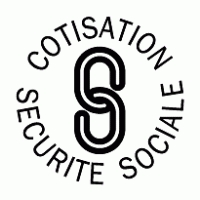 The cotisation symbol has been used between 1984 and 2000. It indicated that tax was payed to counter the health risks involved in immoderate use of the product. Also known as ‘vignette sécurité sociale’ (VSS).
The cotisation symbol has been used between 1984 and 2000. It indicated that tax was payed to counter the health risks involved in immoderate use of the product. Also known as ‘vignette sécurité sociale’ (VSS).
Excise-duty symbols
The following texts and symbols are among many to be found on cognac bottles:
HKDNP = Hong Kong Duty Not Paid. 

Malaysian Duty Not Paid
Duty Free – Philippines
China Duty Not Paid
Singapore Duty Not Paid
Duty Free Sales Only
In Italy small round metal seals were used from around 1930 until 1959:
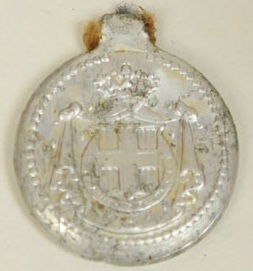 They were attached around the neck with a little rope.
They were attached around the neck with a little rope.
More on this topic on the page ‘How old is my bottle’.
Bla
Bla
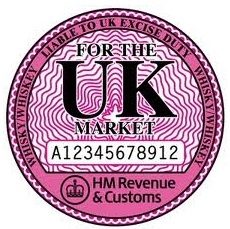 On the left is a seal in use in the UK from 2006.
On the left is a seal in use in the UK from 2006.
bla
bla
bla
Paper seals
A paper sealing of the capsule is used to prevent fraudulous actions and tampering and to warrant the autenticity of the product.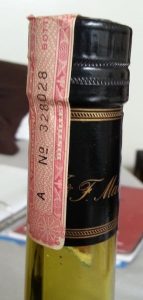
They can also be tax stamps.
In Italy they started using them in 1959 and they are still in use. In the US they began using them in 1934 and stopped around 1985. When a date is stated on such a seal, it is not the bottling date but the date of distillation.
More on this topic on the page ‘How old is my bottle’.
bla
bla
blaa
Französisches Erzeugnis
Stating that the product was produced in France. Used on bottles that were sold in Germany.
Ausländisches Erzeugnis
Stating that the product was produced abroad. This is of course only used on bottles that were sold outside Frace, particularly in Austria.
Ecotax symbols
Recycling symbol, meaning the packaging is subject to ecotax.
Recycling symbol, meaning the packaging is exempted from ecotax.
I don´t know when these symbols were in use, but I have seen them on 1970s bottles.
Échantillon gratuit
This means so much as a ‘free sample’. Usually printed on a miniature bottle that was produced as a give away to make the public acquainted with the product.
Sometimes V.R.P. is added. This stands for Voyageur, représentant, placier. It means the bottle is produce to be given away by persons who work as sales representatives.
Federal Law statement
Federal Law Forbids Sale or Reuse of this Bottle. This sentence was mandatory from 1935 till 1964 on bottles containing alcohol and was placed on the glass in embossed letters.
Government warning
According to US federal law it is obligatory since 1989 to warn drivers and pregnant women against the consumption of alcohol:
GOVERNMENT WARNING:
(1) According to the Surgeon General, women should not drink alcoholic beverages during pregnancy because of the risk of birth defects. (2) Consumption of alcoholic beverages impairs your ability to drive a car or operate machinery, and may cause health problems.
Pregnancy icon
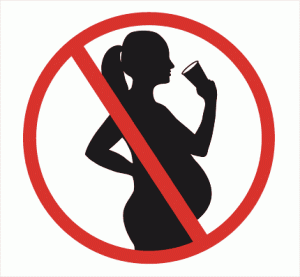 Warns pregnant women not to consume the product (since 2006).
Warns pregnant women not to consume the product (since 2006).
Recycling symbol
This started after 1994. Widely used is the Mobius loop. It only indicates the object is capable of being recycled (first created in 1970 for World Earth Day).
Tidyman symbol
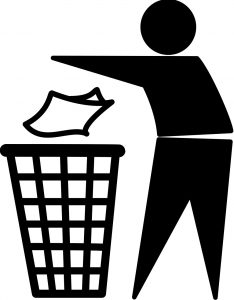 Reminder as to dispose of the material toughtfully, like a good citizen. Invented in de US in the 1950’s. Introduced in the UK after 1969.bla
Reminder as to dispose of the material toughtfully, like a good citizen. Invented in de US in the 1950’s. Introduced in the UK after 1969.bla
bla
bla
Tidyman glass symbol
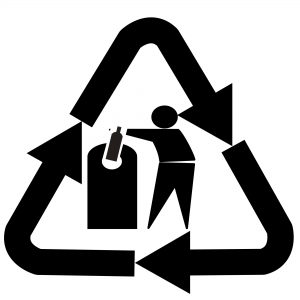 A reminder to throw the glass container in a bin.
A reminder to throw the glass container in a bin.
bla
Green point symbol
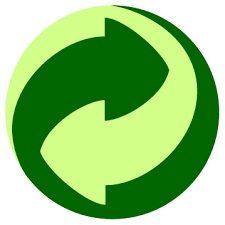 This symbol only means the producing company has contributed financially to recycling processes. Invented in Germany in the early 1990s.bla
This symbol only means the producing company has contributed financially to recycling processes. Invented in Germany in the early 1990s.bla
bla
Don’t drink and drive
Can be seen on bottles from around 2020.
Appendix: milliliters, fluid ounces and more
Usually content is given in milliliter (ml), centiliter (cl) or Liter (L), but you come across other denominators: fluid ounce, pint, quart and gallon. Unfortunately these have different values in the US and the UK.
UK
1 fluid ounce (floz.) equals 2.84cl and is also called imperial fluid ounce to distinguish it from the US fluid ounce. 1 fl.oz. is 1/20th of a pint or imperial pint.
1 pint is 56.83cl and two pints is equal to a quart or imperial quart. So a quart is 113.65cl (rounded off to 114).
1 Gallon equals 160 fluid ounces, which amounts to 4.55L. So 1 Gallon equals 8 pints or 4 quarts.
1 Gallon = 4.55L
1 Quart = 1.14L
1 Pint = 56.8 cl
1 Fluid Ounce = 2.84cl
US
1 fluid ounce (floz.) equals 2.95735296875cl (rounded off to 2.96cl) and is also called US fluid ounce to distinguish it from the imperial fluid ounce in the UK. 1 fl.oz. is 1/16th of a pint or US pint.
1 pint is 47.3176473cl and two pints is equal to a quart or US quart. So a quart is 94.6352946cl (rounded off to 94.6 or 95cl).
1 Gallon equals 128 fluid ounces, which amounts to 3.78L. So 1 Gallon equals 8 pints or 4 quarts.
1 Gallon = 3.78L
1 Quart = 0.95L
1 Pint = 47.3 cl
1 Fluid Ounce = 2.96cl
Canada
The Canadian imperial quart is about 20% more than the US quart, so 1.14L. But there they divide the imperial quart into 40 fluid ounces. So a fluid ounce in Canada is 2.85cl. These sizes are often found on bottles.


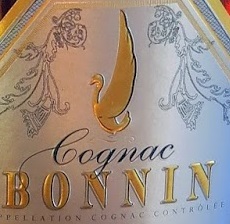

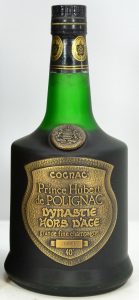
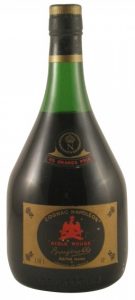

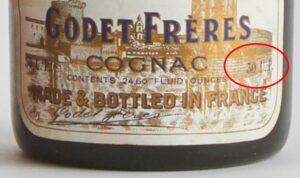
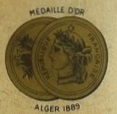
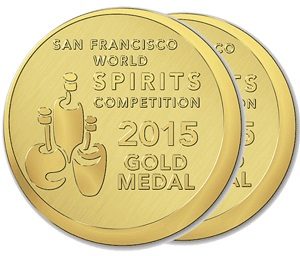
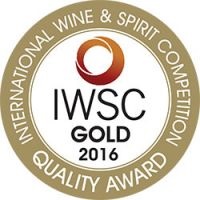
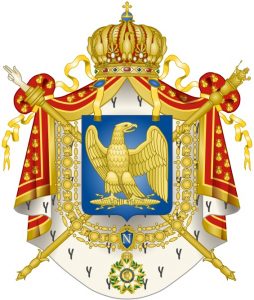


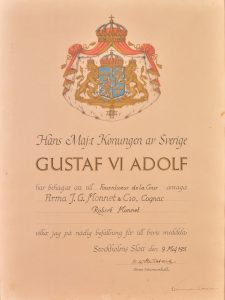
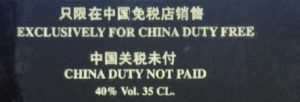
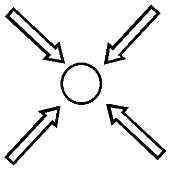

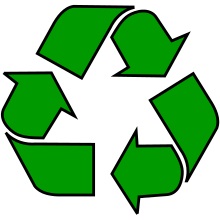
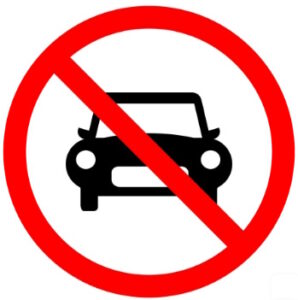
Can you tell me anything about this bottle?
Any info appreciated!
This is from Rouyer Guillet & Co. A Napoleon bottle from the 1970s. Rouyer Guillet was based in Saintes since 1801 (but date of establishment is much older: 1701) and was taken over by CCG in 1992. This Napoleon will bring around €60-80 in an auction.